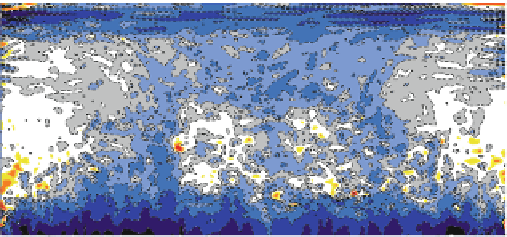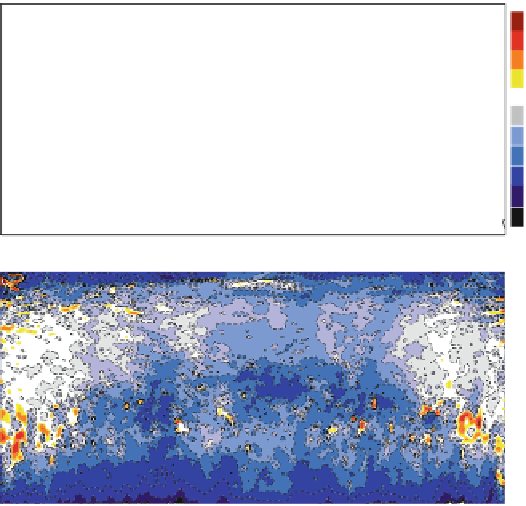Geoscience Reference
In-Depth Information
a
0.2
0.1
0.05
20
0.025
0.01
40
-
0.01
-0.025
-
0.05
60
-0.1
-
0.2
80
-0.4
-
0.8
80N
60 N
40N
20 N
0
20 S
40S
60 S
80S
b
0.4
0.2
0.1
20
0.05
0.025
0.01
-
0.01
40
-
0.025
-0.05
-
0.1
60
-
0.2
-0.4
-
0.8
80
-
1.2
-1.6
80N
60 N
40N
20 N
0
20 S
40S
60 S
80S
Fig. 11.3
Impact of the ECMWF operational linearized physics on the evaluation of (
a
)temper-
ature and (
b
) u-wind increments in zonal mean. Results are presented as the error differences (in
terms of fit to the non-linear model with full physics) between the TL model with full linearized
physics and the purely adiabatic TL model
"
exp
"
adiab
). Negative values are associated with an improvement of the model
using the parametrization schemes with respect to the adiabatic TL model since they
correspond to a reduction of the errors. The improvement is observed over most of
the atmosphere, and is maximum in the lower troposphere.
Figure
11.4
shows the global relative improvement (see (
11.9
)) coming from
including (a) dry physical parametrization schemes (i.e. vertical diffusion, gravity
wave drag, non-orographic gravity wave and radiation) alone and (b) in combination
with the moist processes (i.e. convection and cloud with large-scale parametrization
schemes) in the linearized model compared to adiabatic tangent linear model for
temperature, wind and specific humidity. The additional improvement due to the
inclusion of the moist parametrization schemes is not only coming from these
schemes, but also from cloud-radiation interactions.
The relative error of the TL model with respect to the finite differences using the
full non-linear physical parameterizations is also used for evaluation. Figure
11.5
shows vertical profiles of global relative error reduction (therefore negative values)
of the TL model using different physical parametrization schemes with respect to
the adiabatic TL model. The error reduction becomes larger by gradually including


































































































































































































































































































































































Search WWH ::

Custom Search